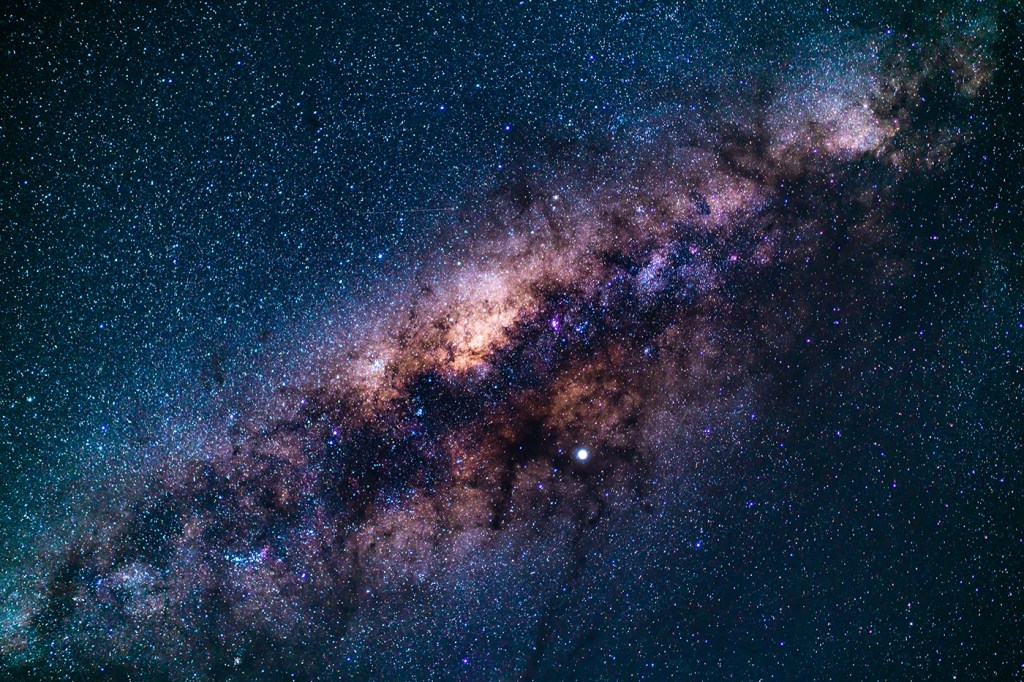New models of Big Bang by Northeastern physicists show that visible universe and invisible dark matter co-evolved
Matthews Distinguished University Professor of physics Pran Nath’s latest cosmological work explores how, at the birth of the universe, dark matter and the visible universe impacted one another.

Physicists have long theorized that our universe may not be limited to what we can see. By observing gravitational forces on other galaxies, they’ve hypothesized the existence of “dark matter,” which would be invisible to conventional forms of observation.
Pran Nath, the Matthews Distinguished University Professor of physics at Northeastern University, says that “95% of the universe is dark, is invisible to the eye.”
“However, we know that the dark universe is there by [its] gravitational pull on stars,” he says. Other than its gravity, dark matter has never seemed to have much effect on the visible universe.
Yet the relationship between these visible and invisible domains, especially as the universe first formed, has remained an open question.
Now, Nath says there is mounting evidence that these two supposedly distinct realms actually co-evolved.

Through a series of computer models, Nath and Ph.D. candidate Jinzheng Li have discovered that the visible and the hidden sectors, as they call them, likely co-evolved in the moments after the Big Bang, with profound repercussions for how the universe developed thereafter.
Nath says there was a time when some physicists effectively wrote off this hidden sector, as we can explain most of what happens within the visible — that is, if our models can accurately portray what we can see happening around us, why bother trying to measure something that has no discernible effect?
“The question is, what’s the influence of the hidden sector on the visible sector?” Nath asks. “But what do we care? We can explain everything.”
But we can’t explain everything, Nath contends. There are anomalies that don’t seem to fit the so-called “Standard Model” of the universe.
That the visible and hidden sectors are mutually isolated is a misconception, Nath says, based on an assumption “that the visible and the hidden sectors evolved independently of each other.” Nath wants to turn that assumption on its head.
Featured Posts
In a new paper published in Physical Review D, “Big Bang Initial Conditions and Self-Interacting Hidden Dark Matter,” co-authored with Li, Nath wants to ask what he calls “the more important question: How do we know that they evolved independently?”
To test this assumption, Nath and his team “introduced some feeble interactions” between the two sectors into their models of the Big Bang. These meager interactions wouldn’t be enough to affect the outcome of, say, particle accelerator experiments, “but we wanted to see what the effects would be on the visible sector as a whole,” Nath says, “from the time of the Big Bang to the current time.”
Even with minimal interactions between the two sectors, Nath and his team discovered that dark matter’s influence on the visible matter we’re made of could have a major impact on observable phenomena.
The Hubble expansion — which says, in the simplest terms, that galaxies are moving away from one another, and thus that the universe is expanding — for instance, contains a “quite serious” differential between what the Standard Model predicts and what has been observed. Nath’s models partially account for this difference.
One major variable is the temperature of the hidden sector during the Big Bang.
The visible sector, we can be fairly certain, started out very hot at the moment of the Big Bang. As the universe cools, Nath says, “what we see is the remnant of that period of the universe.”
But by studying the evolution of the two sectors, Nath and his team could model both conditions — a hidden sector that started out hot, and another hidden sector that started out cold.
What they observed was surprising: Despite significant differences between the models, with major implications on what the universe looked like in early times, both the hot and cold models were consistent with the visible sector we can observe today.
Our current measurements of the visible universe, in other words, are insufficient to confirm which side the hidden sector fell on at the beginning — hot or cold.
Nath is quick to point out that, rather than a failing of the experiment, this is an example of the mathematical models outrunning our current experimental capabilities.
It’s not that the difference between a hot or cold hidden sector has no bearing on the visible universe, but that we haven’t performed experiments — yet — with high enough precision. Nath mentions the Webb Telescope as one example of the next generation of tools that will be able to make such precise observations.
The ultimate goal of all this modeling work is to make better predictions about the state of the universe, how it all functions and what we’ll find when we look deeper and deeper into the night sky.
As our experiments gain more accuracy, the questions baked into Nath’s models — was the hidden sector hot or cold? — will find their answers, and those clarified models will help predict the solutions to ever-deeper questions.
“What’s the significance of this?” Nath asks. Human beings, he says, “want to find their place in the universe.” And more than that, “they want to answer the question, why is there a universe?”
“And we are exploring those issues. It is the ultimate quest of human beings.”










